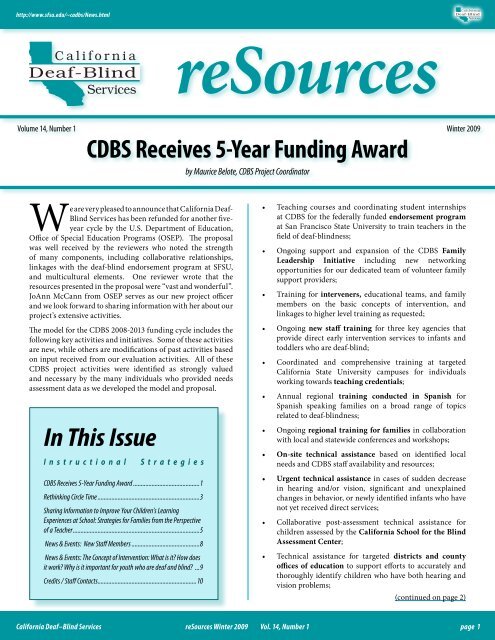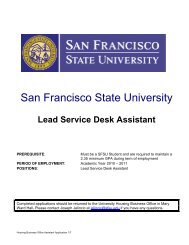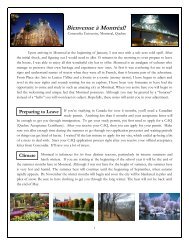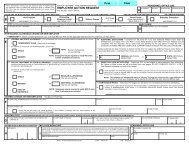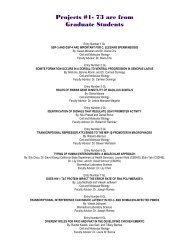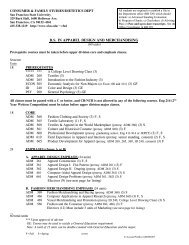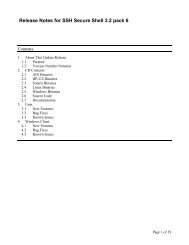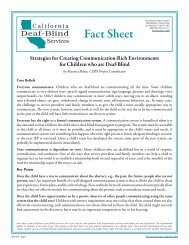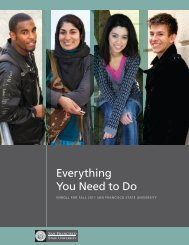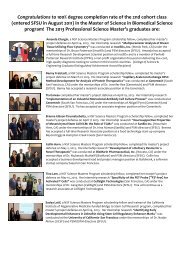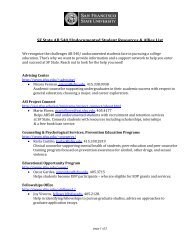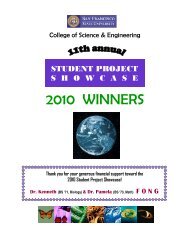reSources Spring 2008 (Vol. 13, No. 2) - San Francisco State ...
reSources Spring 2008 (Vol. 13, No. 2) - San Francisco State ...
reSources Spring 2008 (Vol. 13, No. 2) - San Francisco State ...
Create successful ePaper yourself
Turn your PDF publications into a flip-book with our unique Google optimized e-Paper software.
http://www.sfsu.edu/~cadbs/News.html<br />
California<br />
Deaf-Blind<br />
Services<br />
California<br />
Deaf-Blind<br />
Services<br />
<strong>reSources</strong><br />
<strong>Vol</strong>ume 14, Number 1 Winter 2009<br />
CDBS Receives 5-Year Funding Award<br />
by Maurice Belote, CDBS Project Coordinator<br />
We are very pleased to announce that California Deaf-<br />
Blind Services has been refunded for another fiveyear<br />
cycle by the U.S. Department of Education,<br />
Office of Special Education Programs (OSEP). The proposal<br />
was well received by the reviewers who noted the strength<br />
of many components, including collaborative relationships,<br />
linkages with the deaf-blind endorsement program at SFSU,<br />
and multicultural elements. One reviewer wrote that the<br />
resources presented in the proposal were “vast and wonderful”.<br />
JoAnn McCann from OSEP serves as our new project officer<br />
and we look forward to sharing information with her about our<br />
project’s extensive activities.<br />
The model for the CDBS <strong>2008</strong>-20<strong>13</strong> funding cycle includes the<br />
following key activities and initiatives. Some of these activities<br />
are new, while others are modifications of past activities based<br />
on input received from our evaluation activities. All of these<br />
CDBS project activities were identified as strongly valued<br />
and necessary by the many individuals who provided needs<br />
assessment data as we developed the model and proposal.<br />
In This Issue<br />
I n s t r u c t i o n a l<br />
S t r a t e g i e s<br />
CDBS Receives 5-Year Funding Award............................................1<br />
Rethinking Circle Time...................................................................3<br />
Sharing Information to Improve Your Children’s Learning<br />
Experiences at School: Strategies for Families from the Perspective<br />
of a Teacher...................................................................................5<br />
News & Events: New Staff Members.............................................8<br />
News & Events: The Concept of Intervention: What is it? How does<br />
it work? Why is it important for youth who are deaf and blind? ...9<br />
Credits / Staff Contacts................................................................10<br />
• Teaching courses and coordinating student internships<br />
at CDBS for the federally funded endorsement program<br />
at <strong>San</strong> <strong>Francisco</strong> <strong>State</strong> University to train teachers in the<br />
field of deaf-blindness;<br />
• Ongoing support and expansion of the CDBS Family<br />
Leadership Initiative including new networking<br />
opportunities for our dedicated team of volunteer family<br />
support providers;<br />
• Training for interveners, educational teams, and family<br />
members on the basic concepts of intervention, and<br />
linkages to higher level training as requested;<br />
• Ongoing new staff training for three key agencies that<br />
provide direct early intervention services to infants and<br />
toddlers who are deaf-blind;<br />
• Coordinated and comprehensive training at targeted<br />
California <strong>State</strong> University campuses for individuals<br />
working towards teaching credentials;<br />
• Annual regional training conducted in Spanish for<br />
Spanish speaking families on a broad range of topics<br />
related to deaf-blindness;<br />
• Ongoing regional training for families in collaboration<br />
with local and statewide conferences and workshops;<br />
• On-site technical assistance based on identified local<br />
needs and CDBS staff availability and resources;<br />
• Urgent technical assistance in cases of sudden decrease<br />
in hearing and/or vision, significant and unexplained<br />
changes in behavior, or newly identified infants who have<br />
not yet received direct services;<br />
• Collaborative post-assessment technical assistance for<br />
children assessed by the California School for the Blind<br />
Assessment Center;<br />
• Technical assistance for targeted districts and county<br />
offices of education to support efforts to accurately and<br />
thoroughly identify children who have both hearing and<br />
vision problems;<br />
(continued on page 2)<br />
California Deaf–Blind Services <strong>reSources</strong> Winter 2009 <strong>Vol</strong>. 14, Number 1 page 1
http://www.sfsu.edu/~cadbs/News.html<br />
California<br />
Deaf-Blind<br />
Services<br />
(CDBS Receives 5-Year Funding Award, continued from page 1)<br />
• Electronic distribution of English and Spanish editions of<br />
the CDBS triannual publication <strong>reSources</strong>;<br />
• Improvements to the CDBS website to increase<br />
accessibility;<br />
• Streamlined process for the collection of the annual<br />
census of children who are deaf-blind including electronic<br />
distribution of materials and forms where possible.<br />
CDBS extends its thanks to the following individuals who wrote<br />
letters of support and commitment. These letters were included in<br />
our grant application package. We were careful to connect every<br />
collaborative activity with a letter of support and commitment<br />
to demonstrate the high level of collaborative relationships<br />
CDBS has with so many individuals and organizations. We<br />
are certain these letters had a powerful and positive impact<br />
on the grant reviewers and their approval of our proposal.<br />
• Linda Alsop, Director of Deafblind Programs, SKI•HI<br />
Institute, Utah <strong>State</strong> University<br />
• Dr. Tanni Anthony, Project Director, Colorado Services for<br />
Children and Youth with Combined Vision and Hearing Loss<br />
• Dr. Lyn Ayer, Project Director, Oregon Deafblind Project<br />
• Lizbeth Barclay, Teacher Specialist, California School for<br />
the Blind Assessment Center, Fremont<br />
• Teresa Becerra-Lund, parent and member of the CDBS<br />
Family Leadership Initiative, <strong>No</strong>rth Hills<br />
• Nancy Cornelius, Vice President of the Coalition of Parents<br />
and Educators of the Deaf-Blind (COPE-DB) and member<br />
of the CDBS Family Leadership Initiative, <strong>San</strong> Diego<br />
• Martha De La Torre, parent and member of the CDBS<br />
Family Leadership Initiative, Los Angeles<br />
• Dr. MaryAnn Demchak, Project Director, Nevada Dual<br />
Sensory Impairment Project<br />
• Debra D’Luna, parent and member of the CDBS Family<br />
Leadership Initiative, Irvine<br />
• Juno Duenas, Executive Director, Support for Families,<br />
<strong>San</strong> <strong>Francisco</strong><br />
• Mary Goldman, Director, Infant-Family Program, Junior<br />
Blind of America, Los Angeles<br />
• Kathryn Goodspeed, Early Childhood Coordinator/<br />
Assistant Executive Director, Blind Children’s Learning<br />
Center, <strong>San</strong>ta Ana<br />
• Dr. Robin Greenfield, Project Director, Idaho Project for<br />
Children and Youth with Deaf-Blindness<br />
• Dr. Ann Halvorsen, Professor, California <strong>State</strong> University<br />
East Bay<br />
• Dr. Nancy Hatfield, Project Co-Director, Washington<br />
<strong>State</strong> Services for Children with Deaf-Blindness<br />
• Cathy Kirscher, Regional Representative, Helen Keller<br />
National Center, <strong>San</strong> Diego<br />
• Alba Marquez, parent and member of the CDBS Family<br />
Leadership Initiative, Whittier<br />
• Cathy Mouchka, consumer, Sacramento<br />
• Tom Neary, SELPA Support Coordinator, Placer County<br />
Office of Education, Auburn<br />
• Gina Quintana, Project Coordinator, Colorado Services for<br />
Children and Youth with Combined Vision and Hearing Loss<br />
• Shelly Rempe, Principal, Special Needs Department,<br />
California School for the Deaf-Riverside<br />
• Virginia Reynolds, Program Director, WestEd Center for<br />
Prevention and Early Intervention, Sacramento<br />
• Herlinda Rodriguez, parent and member of the CDBS<br />
Family Leadership Initiative, Downey<br />
• Dr. <strong>San</strong>dra Rosen, Professor, Coordinator of Program in<br />
Orientation and Mobility, <strong>San</strong> <strong>Francisco</strong> <strong>State</strong> University<br />
• Richard Rueda, Transition Coordinator/Vocational<br />
Counselor, Blind Field Services, California Department of<br />
Rehabilitation, Oakland<br />
• Kathee Scoggin, Project Co-Director, Washington <strong>State</strong><br />
Services for Children with Deaf-Blindness<br />
• Bethany Stark, parent and member of the CDBS Family<br />
Leadership Initiative, Pacific Palisades<br />
• Tom Udell, Technical Assistance Specialist, National<br />
Consortium on Deaf-Blindness, Monmouth, Oregon<br />
• Joanne Whitson, Project Director, Wyoming Deaf-Blind<br />
Project<br />
• Dr. Linda Wyatt, Special Education Consultant, Special<br />
Education Division, California Department of Education,<br />
Sacramento<br />
v<br />
California Deaf–Blind Services <strong>reSources</strong> Winter 2009 <strong>Vol</strong>. 14, Number 1 page 2
http://www.sfsu.edu/~cadbs/News.html<br />
California<br />
Deaf-Blind<br />
Services<br />
Rethinking Circle Time<br />
By Maurice Belote, CDBS Project Coordinator<br />
What is it about circle time with children who<br />
are deaf-blind that causes such consternation<br />
among educators? At its best, circle time<br />
can be a positive tool for building social awareness,<br />
communication skills, and a sense of connectedness<br />
among peers. But it can also sap energy from puzzled team<br />
members who struggle to find ways to include children<br />
who are deaf-blind in this traditional activity that occurs<br />
in most classrooms at some point during the school day.<br />
minutes with their classmates and teachers, everyone sits<br />
in a circle and says good morning to one another. But<br />
the “good mornings” were all said when the children<br />
first arrived to school. Think of that awkward situation<br />
many of us have experienced when someone says good<br />
morning to you at work for the second time in one day.<br />
In the culture of greetings, we are allowed only one<br />
“good morning” for a particular person each day. There<br />
is an expectation that each subsequent interaction will<br />
include a fresh choice from the menu of greeting options.<br />
Morning circle time seems to be a fairly typical part of most<br />
preschools and is an equally pervasive activity in most<br />
special day classes—regardless of the age of the students.<br />
In general education, the concept of morning circle still<br />
often exists, although it takes other forms as students age.<br />
In elementary school, it might be a time to talk about the<br />
schedule for the day, and hear about upcoming classroom<br />
events, relevant local and world news, sharing, etc. The<br />
instructional day of many middle and high schools starts<br />
with first-period homerooms, during which students<br />
receive announcements about extracurricular events<br />
such as athletic games, dances, fundraisers, etc. This<br />
is usually a motivating time for high school students<br />
because this is the age when many students become<br />
more interested in elective courses and extracurricular<br />
activities than in the more traditional, academic subjects.<br />
Most circle time activities are primarily built around<br />
visual and auditory activities (e.g., verbal greetings,<br />
the singing of songs, and the use of wall charts). Many<br />
components of a traditional circle time, therefore, can be<br />
downright confusing and/or inaccessible to a child with<br />
hearing and vision loss. It shouldn’t seem surprising that<br />
many children who are deaf-blind “fail” circle time—by<br />
refusing to sit quietly, by engaging in behaviors that<br />
will likely result in being removed from the activity,<br />
or simply by refusing to go to the circle area at all.<br />
Children with typically developing language might<br />
understand that this is like a game. We say good morning<br />
at circle because we look at each other and enjoy the<br />
verbal and non-verbal responses our greetings elicit.<br />
Another morning circle activity that some children will<br />
rightly perceive as a game is when we ask children to tell<br />
us our name. Even more puzzling to children who are<br />
deaf-blind might be when we ask them to tell us their<br />
own names. Can you imagine what a child who is deafblind<br />
might be thinking when a familiar adult asks them<br />
their name? I imagine they must be thinking, “Well, if<br />
you don’t know my name by now, then I just give up”.<br />
We always want to consider the age-appropriateness<br />
of morning circle activities and make necessary<br />
modifications/adaptations to the activities so that they<br />
are consistent with what other children of the same age<br />
need and want. If you’re not sure about what children<br />
of a certain age are interested in, just ask some nondisabled<br />
peers. They will gladly share their lists of<br />
favorite singers, movies, radio stations, TV shows, etc.<br />
For example, while it may be traditional to sing a good<br />
morning song, what a delight it might be for a student<br />
with some usable hearing to recognize music that<br />
is played at a school assembly or dance because that<br />
student has heard the songs many times during morning<br />
group. If the student is an occasional hearing aid or<br />
cochlear implant user, this might be the time the student<br />
willingly chooses to use his or her assistive technology.<br />
Much of what constitutes traditional circle time is basically<br />
irrelevant to children who are deaf-blind. For example,<br />
consider a preschool classroom in which circle time<br />
occurs after the children have come in from the bus, put<br />
away their backpacks, used the bathroom, had breakfast,<br />
and brushed their teeth. After having spent many (continued on page 4)<br />
California Deaf–Blind Services <strong>reSources</strong> Winter 2009 <strong>Vol</strong>. 14, Number 1 page 3
http://www.sfsu.edu/~cadbs/News.html<br />
California<br />
Deaf-Blind<br />
Services<br />
(Rethinking Circle Time, continued from page 3)<br />
Facilitating positive peer interactions often requires<br />
creativity planning to get the interactions off the ground,<br />
and morning circle provides many opportunities for<br />
facilitated interactions. For example, you might consider<br />
giving the student who is deaf-blind some “power” during<br />
circle time. One way this can be accomplished is to<br />
give the child who is deaf-blind something that the other<br />
students want or need. This might be snacks, keys to<br />
the snack closet, change for the vending machines, recess<br />
passes, name badges, or other items of importance that<br />
the student can be responsible for handing out to the<br />
others. The student gets the self-esteem boost of being<br />
responsible for something important and, at the same<br />
time, is allowed to be on the giving end of peer interactions.<br />
Children who are deaf-blind must understand the context<br />
of circle time activities so that they can make sense of what<br />
is being asked of them. Clapping hands or banging rhythm<br />
sticks together won’t have any special meaning for students<br />
who cannot hear the music that other students can hear.<br />
While it feels good to us as teachers to see all students<br />
participating, the child who is deaf-blind may really just be a<br />
passive participant in the activity because of reduced and/or<br />
distorted access to the environment. Another challenge of<br />
creating context for children who are deaf-blind is making<br />
experiences real in the truest sense, so that children can<br />
build their own experiences out of real activities with real<br />
materials. It may not be sufficient to have the child hold<br />
a stuffed toy rabbit while the group sings “Here comes<br />
Peter Cottontail” since visual memory and experience<br />
are usually necessary in order for a child to make the<br />
connection between an actual rabbit and a stuffed animal.<br />
It is also important to consider hearing and vision issues.<br />
If activities of circle time are primarily visual and auditory<br />
in nature, then these activities lose their relevance for the<br />
student who is deaf-blind. The question then becomes:<br />
what is the benefit to the child who is deaf-blind to<br />
continue to participate in this activity? It may be possible<br />
to increase active engagement by simply modifying<br />
the physical environment to maximize the student’s<br />
vision and hearing. Examples of these environmental<br />
modifications might include the following: moving the<br />
child to a different location within the circle, allowing<br />
the child to use a different chair or piece of equipment<br />
in order to maximize postural control and sensory<br />
input, or allowing the child to move more than the<br />
others in order to get closer to materials being presented.<br />
The educational team may decide that the child who<br />
is deaf-blind doesn’t need to join the class for the entire<br />
morning circle activity, but can do some of the activities<br />
and then leave the group to do something else. For<br />
example, a typical circle time activity involves identifying<br />
classmates and staff who are at school that day and those<br />
who are absent. Perhaps each child and staff member in<br />
the class can be assigned a tactile marker that is affixed to<br />
a laminated card that also includes each child or adult’s<br />
name and photo. Everyday at circle time, these cards can<br />
be separated into two groups: those who are present and<br />
those who are absent. Once this information is collected,<br />
the child who is deaf-blind can deliver the stack of “absent<br />
cards” to the attendance clerk in the school office. In this<br />
way, it isn’t an issue of whether or not the child participates<br />
in circle time, but rather an issue of how much participation<br />
is meaningful to the child and what parts of circle time<br />
can be replaced with activities that are more relevant.<br />
Lastly, issues of pacing and turn taking may need to be<br />
considered to make sure students are actively engaged in<br />
the activities of circle time. The pace of the entire activity<br />
may need to be slowed down considerably to allow the<br />
student who is deaf-blind the time needed to make sense<br />
of what is happening and to prepare for each component<br />
of the activity. While the pace slows, it may seem<br />
paradoxical to suggest that some circle time activities<br />
might occur too slowly for a student with limited vision<br />
and hearing. Think about the turn taking that is usually<br />
required for circle activities, and the way that students<br />
follow the order of turns and the excitement that comes<br />
with the anticipation of their own involvement in each<br />
activity. Turn taking is primarily a visual and auditorally<br />
based activity. Students with typically developing vision<br />
and hearing watch and/or listen to the others in the group<br />
and use this time to mentally and physically prepare<br />
for their turns. Without access to this information,<br />
it may not make sense to a child who is deaf-blind to<br />
spend so much time waiting and sitting quietly when<br />
it isn’t clear why these periods of quiet are interjected<br />
with what must seem like random bouts of engagement.<br />
Comments? Questions?<br />
Email the author: mbelote@sfsu.edu<br />
v<br />
California Deaf–Blind Services <strong>reSources</strong> Winter 2009 <strong>Vol</strong>. 14, Number 1 page 4
http://www.sfsu.edu/~cadbs/News.html<br />
California<br />
Deaf-Blind<br />
Services<br />
Sharing Information to Improve Your Children’s<br />
Learning Experiences at School: Strategies for<br />
Families from the Perspective of a Teacher<br />
By Gloria Rodriguez-Gil, CDBS Educational Specialist<br />
There are many important reasons for families to share<br />
basic information about their children with classroom<br />
staff and other service providers in school. These<br />
include to help children function at their best in order to<br />
facilitate learning, to lessen the time it takes service providers<br />
to get to know their students so they can get started working on<br />
educational goals, and to facilitate collaborative relationships<br />
with service providers from the very beginning.<br />
To begin with, let me share a recent story from my travels<br />
around California. Three weeks into this school year I visited a<br />
preschool classroom to observe a student I will call Sophie. The<br />
day began with the students eating breakfast with the support<br />
of the teaching staff. One of the breakfast choices on this day<br />
was bagel with cream cheese, and a classroom assistant cut the<br />
bagel into small pieces for Sophie. The assistant picked up a<br />
piece of bagel with a fork and offered it to Sophie by placing it<br />
in front of Sophie’s face at a close enough distance for her to<br />
see it (Sophie has vision loss). Sophie responded by refusing<br />
to open her mouth. I asked the classroom assistant if Sophie<br />
liked bagels and she responded by saying that she didn’t know<br />
what Sophie liked to eat. The classroom teacher explained to<br />
me later that Sophie had been in school for only three weeks.<br />
As the classroom assistant cut the bagel into pieces, I remember<br />
wondering if this particular student could really eat something<br />
like a bagel even if it was cut into small pieces. Sophie had<br />
significant motor challenges and walked with the aid of a<br />
walker. In addition, she was hard of hearing and communicated<br />
mainly through behaviors and actions (although she was able<br />
to imitate a few words when she was highly motivated, as she<br />
demonstrated later during the observation.) Since she didn’t<br />
communicate orally, I realized that some of her eating skills—<br />
particularly chewing—might be impacted by the development<br />
of oral-motor skills. The possibility that Sophie could chew<br />
and swallow something as hard as a piece bagel seemed low.<br />
In the end, the breakfast activity was not a very positive and<br />
constructive experience for Sophie.<br />
Sophie’s breakfast experience might have been more positive if<br />
Sophie’s family and school staff had communicated beforehand<br />
about Sophie’s feeding preferences, habits, and needs. With<br />
better information sharing, Sophie might not have been viewed<br />
as an uncooperative child or a child who could not understand<br />
and respond appropriately. Although this situation is specific<br />
to Sophie and her program, it is an example of something that<br />
is much more common, and happens to students when basic<br />
information has not been communicated clearly and timely.<br />
Professionals and paraprofessionals working with your<br />
child—especially when your child is new to a program—may<br />
not understand your child’s basic needs and other important<br />
information because their information is based only on brief<br />
observations in the classroom. The knowledge you have of<br />
your child is based on so much personal experience that it may<br />
be obvious to you, but may not come as naturally to service<br />
providers in the school. There may be written reports about<br />
your child but these reports do not provide a complete day-today<br />
“picture” of who your child really is. And not all service<br />
providers have easy access to these reports. Unfortunately,<br />
having provided information about your child once doesn’t<br />
mean that you may not have to provide it many more times.<br />
This will be particularly true every time the child goes into<br />
a new program and/or starts working with new people. And<br />
some information may have to be repeated several times to<br />
the same people for them to fully understand it in the way<br />
intended.<br />
In many cases, it is difficult for children who have vision and<br />
hearing loss and additional multiple disabilities to tell others<br />
about themselves. It is usually the responsibility of family<br />
members and/or the other adults who live with and care for<br />
these students to share this information so that educational<br />
teams can propose and design instructional activities based on<br />
the strengths and needs of the students. You can insure this<br />
information is shared by considering a few simple strategies.<br />
These strategies might be most applicable to a student who is<br />
new to a program.<br />
Who is the Child?<br />
You want to start by giving a positive view of your child (e.g.,<br />
who she is as a person, her personality, things she’s good at, and<br />
the things she likes and doesn’t like to do). This information<br />
(continued on page 6)<br />
California Deaf–Blind Services <strong>reSources</strong> Winter 2009 <strong>Vol</strong>. 14, Number 1 page 5
http://www.sfsu.edu/~cadbs/News.html<br />
California<br />
Deaf-Blind<br />
Services<br />
(Sharing Information to Improve Your Children’s Learning Experiences at School, continued from page 5)<br />
will help service providers design activities based on her<br />
preferences and strengths. From this starting point, they will<br />
be able to build activity sets that are rewarding and gradually<br />
more challenging for the child. Information about things<br />
that she doesn’t like will also give service providers important<br />
information about activities that challenge your child, so that<br />
strategies can be identified to overcome theses challenges or<br />
to work around them. Sometimes dislikes are a result of lack<br />
of experiences or a result of physical or neurological issues the<br />
child has.<br />
Considerations:<br />
1. Helping service providers to know your child’s personality<br />
will help them to view her as the person she is, well beyond her<br />
disabilities.<br />
2. When providing information about what she likes, try to<br />
share specific examples of things, people, activities and places.<br />
3. The things that she is good at can be big or small, things she<br />
can do on her own or things that she needs assistance with.<br />
They might even be activities she needs complete support for,<br />
but to which she responds positively or make her happy.<br />
The Diagnosis<br />
If you have a diagnosis for your child’s vision and hearing<br />
problems, share this information with your child’s service<br />
providers. Many causes of deaf-blindness are relatively<br />
rare, and it is quite likely that not all service providers will<br />
know and understand the characteristics and implications<br />
of this diagnosis. In addition, there are differences between<br />
children with the same diagnosis so it is important to provide<br />
information on how specific characteristics of this diagnosis<br />
are or are not present in your child.<br />
Considerations:<br />
1. Is there a website or print resource you particularly like, that<br />
you think captures information about your child’s diagnosis<br />
in a way that is easy for others to understand? If so, share<br />
information with your child’s team on how to access this<br />
information.<br />
2. You may hear generalizations made about your child—based<br />
on a diagnosis—that don’t sound like they apply to your child<br />
and her specific situation. If this happens, speak up and explain<br />
the difference between your child and others with a similar<br />
diagnosis. It will be helpful to others to better understand<br />
these distinctions.<br />
Vision and Hearing Loss, and the Other Senses<br />
We all gather information and access our world through our<br />
senses. When the two primary senses (i.e., vision and hearing)<br />
for gathering information are reduced or distorted, you want<br />
your child to make the best use of these senses that she can.<br />
Residual vision and hearing can be used in combination with<br />
the other senses such as touch and smell to provide as much<br />
information to the child as possible.<br />
Considerations:<br />
1. Provide any available medical information and test results<br />
of your child’s vision and hearing loss with members of her<br />
educational team. But more important are your observations<br />
about how your child uses her vision and/or hearing in her daily<br />
life. For example, can she see light, silhouettes, bright objects,<br />
or pictures? Can she see you when you come into the room?<br />
Can she hear the sound of a passing truck? Does she calm to<br />
the sound of soothing music? Does she respond to her name<br />
or to simple requests? Remember, all information is important<br />
even if the child’s responses are very subtle or obvious to you.<br />
2. Give the educational team information about any visual<br />
and/or hearing aids that your child uses to help maximize the<br />
use of residual vision and hearing. What are these devices and<br />
how does the child use them? How often does the child use<br />
them and in what situations?<br />
3. Pay attention to the environments your child likes and<br />
dislikes. Is the child sensitive to visual stimuli such as light,<br />
or to auditory input like loud noises? What kind of auditory<br />
environment does she respond better to? Does she like<br />
movement games like swinging? Does she like to spend time<br />
swimming or bathing? Does she like big hugs?<br />
4. Which senses does she prefer to use when exploring the<br />
environment and learning new things? Is it vision, hearing, or<br />
touch or a combination of these? Does she use the sense of<br />
smell to identify places, food and people?<br />
5. When she is restless, what activities do you do with her to<br />
calm her? When she is withdrawn, what activities do you do<br />
to stimulate her?<br />
Additional Disabilities<br />
Many children who have combined vision and hearing<br />
problems also have additional disabilities.<br />
Considerations:<br />
1. Does your child have motor problems? What is the special<br />
equipment that she uses and how does she use it? What kinds<br />
of support does she need in order to move or to sit up? What is<br />
the best way to support her physically?<br />
2. Does she have behavior related issues? What are the<br />
strategies that have been used to respond to your child’s<br />
behavior patterns?<br />
3. Does your child have difficulty learning? Under what<br />
situations does she learn best? What has helped her learn new<br />
things, such as activities, concepts, or signs?<br />
(continued on page 7)<br />
California Deaf–Blind Services <strong>reSources</strong> Winter 2009 <strong>Vol</strong>. 14, Number 1 page 6
http://www.sfsu.edu/~cadbs/News.html<br />
California<br />
Deaf-Blind<br />
Services<br />
(Sharing Information to Improve Your Children’s Learning Experiences at School, continued from page 6)<br />
4. Does your child have medical/health related issues? Is<br />
she taking any medications that could impact her level of<br />
engagement in the classroom? If she doesn’t eat regular foods,<br />
what is her diet and your goals for eating? Does she have<br />
problems napping or sleeping through the night? Are there<br />
special provisions in the case of medical emergencies that the<br />
school staff should be aware of?<br />
Communication<br />
Most children who are deaf-blind have challenges with<br />
receptive and expressive communication. Many have difficulty<br />
expressing their wants and needs, socializing with and<br />
understanding others, and learning new concepts in school.<br />
Communication is involved in every activity throughout the<br />
day and with every person your child interacts with. The ways<br />
in which your child communicates might be clear, or may need<br />
to be explained so that she can be understood by others. Give<br />
service providers the clearest description you can about how<br />
your child communicates, especially communication strategies<br />
you use at home.<br />
Considerations:<br />
1. How does your child communicate through behavior? How<br />
else does your child communicate? Through gestures, signs,<br />
words, or a combination of these?<br />
2. Be as specific as you can when sharing information about<br />
communication. Your child’s communication system is very<br />
unique to her, so the more information the better.<br />
3. Whenever possible, it is very helpful to provide information<br />
about your child in writing. Written information about your<br />
child’s communication system can be shared more easily and<br />
accurately across team members at school.<br />
Ideas for sharing information can vary depending on the<br />
particular child and specific needs. What I’ve included<br />
here are just a few of the types of information you may want<br />
to share with your child’s service providers. Channels of<br />
communication need to be open throughout the year so that<br />
school staff is aware of new information that may help your<br />
child in school. The most important thing is to share this<br />
information so that you minimize time lost in order to move<br />
your child’s education forward.<br />
Job Opportunity at CDBS!<br />
The <strong>No</strong>rthern California CDBS Family<br />
Specialist position is currently vacant, as<br />
a result of Jackie Kenley’s retirement last<br />
Fall. Anyone interested in applying for the<br />
position should visit the <strong>San</strong> <strong>Francisco</strong> <strong>State</strong><br />
University Human Resources website and<br />
search for job ID #: 1932<br />
Are you<br />
interested<br />
in teaching?<br />
Find out about an innovative<br />
new teacher training program in<br />
deaf-blindness. Visit:<br />
http://www.sfsu.edu/~spedcd/<br />
Comments? Questions?<br />
Email the author: gloria.gil@gte.net<br />
v<br />
University–CDBS<br />
Partnership Project<br />
California Deaf–Blind Services <strong>reSources</strong> Winter 2009 <strong>Vol</strong>. 14, Number 1 page 7
http://www.sfsu.edu/~cadbs/News.html<br />
California<br />
Deaf-Blind<br />
Services<br />
NEWS AND EVENTS<br />
CDBS Welcomes New Staff!<br />
Dr. Pam Hunt<br />
Project Director<br />
Dr. Pam Hunt now serves as CDBS Project Director. Pam is a Professor in the<br />
Department of Special Education at <strong>San</strong> <strong>Francisco</strong> <strong>State</strong> University and is<br />
Program Coordinator of the SFSU Moderate/Severe Disabilities Area Programs.<br />
She has served at a principal investigator for numerous federally funded<br />
research and demonstration projects and also serves on the editorial boards of<br />
three academic journals in the field of special education and inclusion. She is a<br />
nationally recognized leader in the field of inclusive education for students with<br />
significant disabilities, including students with deaf-blindness. Pam also serves<br />
as Project Director of the federally funded University-Community Partnership<br />
to Effectively Prepare Teachers to Serve Students with Deaf-Blindness.<br />
Pam can be reached at hunt@sfsu.edu.<br />
Ty Eng Lim joined CDBS in December as the project’s new Administrative<br />
Support Coordinator. Ty is a graduate of Hunter College in New York and<br />
currently attends SFSU in the Instructional Technology MA Program. He has<br />
extensive experience working with a variety of nonprofit organizations. He<br />
will be responsible for a number of project activities, including the California<br />
census of children who are deaf-blind, the CDBS newsletter <strong>reSources</strong>, the<br />
CDBS website, and numerous project databases.<br />
Ty can be reached at tylim@sfsu.edu.<br />
Ty Eng Lim<br />
Administrative Support<br />
Coordinator<br />
CDBS Continuing Staff<br />
Dr. Barbara Franklin<br />
Principal Investigator<br />
David Brown<br />
Educational Specialist<br />
Gloria Rodriguez-Gil<br />
Educational Specialist<br />
Maurice Belote<br />
Project Coordinator<br />
Myrna Medina<br />
Family Specialist<br />
California Deaf–Blind Services <strong>reSources</strong> Winter 2009 <strong>Vol</strong>. 14, Number 1 page 8
http://www.sfsu.edu/~cadbs/News.html<br />
California<br />
Deaf-Blind<br />
Services<br />
NEWS AND EVENTS<br />
California Deaf-Blind Services Announces <strong>No</strong>rthern and Southern California<br />
Training for Interveners* and Educational Teams<br />
“The Concept of Intervention: What is it?<br />
How does it work? Why is it important for<br />
children and youth who are deaf-blind?”<br />
Saturday, March 21, 2009<br />
9:00 a.m. – 4:00 p.m. (same day and times for both locations)<br />
This training will be a general introduction to the concept of intervention.<br />
The agenda will include the following:<br />
• The roles and responsibilities of the intervener, teacher, and<br />
administrator<br />
• The impact of deaf-blindness on development, communication and<br />
language<br />
• Making modifications and adaptations to the curriculum to meet<br />
the unique needs of students who are deaf-blind<br />
• The ethics of intervention and strategies for successful teaming<br />
Locations<br />
NORTHERN CALIFORNIA<br />
CDBS offices in Daly City (just<br />
south of SF and the SFSU campus)<br />
SOUTHERN CALIFORNIA<br />
Blind Children’s Learning Center in<br />
<strong>San</strong>ta Ana (central Orange County)<br />
For more information about this training or to receive registration<br />
materials, contact Maurice Belote, CDBS Project Coordinator, at:<br />
mbelote@sfsu.edu or 415-405-7558<br />
* one-on-one service providers with specialized training and skills in deaf-blindness<br />
California Deaf–Blind Services <strong>reSources</strong> Winter 2009 <strong>Vol</strong>. 14, Number 1 page 9
California<br />
Deaf-Blind<br />
Services<br />
<strong>reSources</strong><br />
Editor............................................................. Maurice Belote<br />
Design & Layout.................................................Ty Eng Lim<br />
CDBS <strong>reSources</strong> is published by California Deaf-Blind<br />
Services. CDBS is supported by the U.S. Department of<br />
Education, Office of Special Education Programs (OSEP<br />
Award H326C080009). Opinions expressed herein are<br />
those of the authors and do not necessarily reflect the<br />
position of the U. S. Department of Education. There<br />
are no copyright restrictions to this document. You are<br />
welcome to copy and share this information freely. Please<br />
credit California Deaf-Blind Services and OSEP when<br />
reprinting.<br />
California<br />
Deaf-Blind<br />
Services<br />
Staff<br />
(800) 822-7884 voice/tty<br />
Maurice Belote.................................... Project Coordinator<br />
David Brown ...................................Educational Specialist<br />
Barbara Franklin, Ph.D...................Principal Investigator<br />
Pam Hunt, Ph.D......................................... Project Director<br />
Ty Eng Lim............ Administrative Support Coordinator<br />
Myrna Medina..........................................Family Specialist<br />
Gloria Rodriguez-Gil......................Educational Specialist<br />
(Vacant)......................................................Family Specialist<br />
California Deaf-Blind Services<br />
1600 Holloway / Pacific Plaza<br />
<strong>San</strong> <strong>Francisco</strong>, CA 94<strong>13</strong>2-4201<br />
(415) 405-7560 v o z /t t y<br />
(415) 405-7562 fa x<br />
www.sfsu.edu/~cadbs<br />
California Deaf-Blind Services<br />
<strong>San</strong> <strong>Francisco</strong> <strong>State</strong> University<br />
1600 Holloway / Pacific Plaza<br />
<strong>San</strong> <strong>Francisco</strong>, CA 94<strong>13</strong>2-4201<br />
ADDRESS SERVICE REQUESTED


